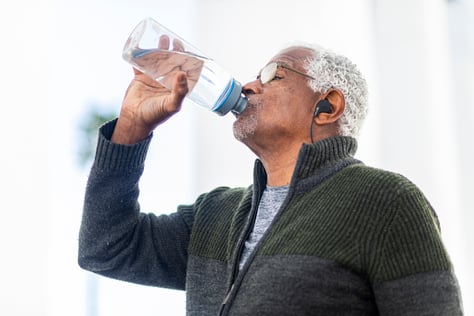 These are both great questions and very important to the older adult population. I hear all the time that people don’t like to drink water because they will need to go the restroom more. This can be an inconvenient especially during the night but in the long term we need to make sure we stay hydrated. Proper hydration is essential in keeping multiple systems of the body functioning properly. Most people need to drink at least three liters of water per day. You can get this water from many different sources including vegetables. If you can get one liter from what you eat during the day with a fruit and vegetable rich diet, then you will only need to drink two liters.
These are both great questions and very important to the older adult population. I hear all the time that people don’t like to drink water because they will need to go the restroom more. This can be an inconvenient especially during the night but in the long term we need to make sure we stay hydrated. Proper hydration is essential in keeping multiple systems of the body functioning properly. Most people need to drink at least three liters of water per day. You can get this water from many different sources including vegetables. If you can get one liter from what you eat during the day with a fruit and vegetable rich diet, then you will only need to drink two liters.
You need to make sure that your fluid needs are also based on activity levels. If you are more sedentary you will not need to consume as much water as if you are out doing intense activity or spending time in the heat. Fluid intake also will need to be increased during times of illness and dehydration. Medication can also increase the need for water intake. As always make sure you are having some of these discussions with your physician. The signs of dehydration can be headaches, fatigue, low blood pressure, dizziness, and nausea. Dehydration occurs when you are losing more water than you take in. When you do feel thirsty make sure to drink water as soon as possible. Delaying water intake will result in dehydration faster. Fad diets can also increase the need of water. When you feel thirsty you want to drink water as soon as possible.
It can be very beneficial to start your day with at least one glass of water. You can have this before breakfast or with your breakfast. This will help to get you on the right track for the rest of the day. I try and have another glass around 10am and then one before lunch. If you are trying to lose weight, drinking water will help you to not overeat as you will feel full sooner. In addition if you are exercising or working outdoors, make sure you have water close by and regularly drink to replace the fluids you are losing through activity.
They make all sorts of flavoring for water to help avoid the same bland taste or you can add sliced fruit for added flavor. I also try to drink a glass of water about half an hour before I go to bed, this allows enough time for me to use the restroom before I go to sleep not disturbing me during the night. This will also help to keep you from dehydration during the night and make sure your body is functioning at its highest level. Interested in better tracking your water intake? You can also purchase a water bottle that will have a measurement to show how much you should drink per hour or allow you to track overall ounces through the day as you drink and refill.


.jpg?width=300&name=GettyImages-816941230%20(1).jpg) A member recently asked me how they can stay active while they are traveling or otherwise unable to make it to the gym. Here I’ll discuss several different topics to address the issue, taking into consideration space, time, equipment, and the individual’s goals. Our members’ ages are between 67 and 100, so the goals will vary depending on functional ability.
A member recently asked me how they can stay active while they are traveling or otherwise unable to make it to the gym. Here I’ll discuss several different topics to address the issue, taking into consideration space, time, equipment, and the individual’s goals. Our members’ ages are between 67 and 100, so the goals will vary depending on functional ability.
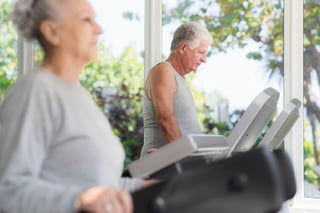 This blog was updated on March 22, 2017.
This blog was updated on March 22, 2017.
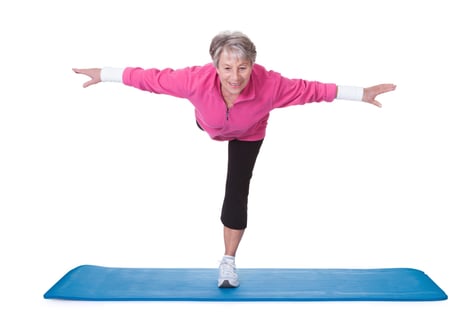 You might know that some of the basic elements your senior fitness workout program should include are weight training, cardio activities, and as much flexibility as possible. One element that needs special attention among the senior population is
You might know that some of the basic elements your senior fitness workout program should include are weight training, cardio activities, and as much flexibility as possible. One element that needs special attention among the senior population is 
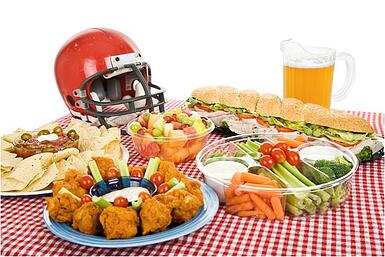 It’s that time of the year again: football season. With every year comes a clean slate for each team. Rosters are changed, stars have yet to emerge, and the underdog team is nowhere close to being discovered. With the changes the football season brings, have you ever considered your dietary habits for the season? Similar to the new football season ahead, do you plan to change your eating or drinking habits for football Sunday?
It’s that time of the year again: football season. With every year comes a clean slate for each team. Rosters are changed, stars have yet to emerge, and the underdog team is nowhere close to being discovered. With the changes the football season brings, have you ever considered your dietary habits for the season? Similar to the new football season ahead, do you plan to change your eating or drinking habits for football Sunday?
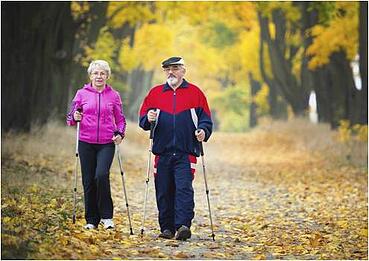 Over the years, it is easy to forget about exercise when it’s not routine. Remaining sedentary over life can lead to metabolic disorders and other diseases associated with physical inactivity. A recent
Over the years, it is easy to forget about exercise when it’s not routine. Remaining sedentary over life can lead to metabolic disorders and other diseases associated with physical inactivity. A recent 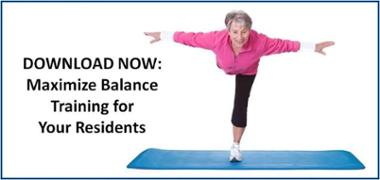
 What are some challenges in developing group fitness classes for active older adults? One of the hardest things for me is that there is a wide variety in exercise knowledge and ability. For example, you might have someone who has never exercised a day in their life sitting next to someone who has been exercising in a gym for decades. Or, you may have someone in their middle 60s next to someone who is 85 with two knee replacements.
What are some challenges in developing group fitness classes for active older adults? One of the hardest things for me is that there is a wide variety in exercise knowledge and ability. For example, you might have someone who has never exercised a day in their life sitting next to someone who has been exercising in a gym for decades. Or, you may have someone in their middle 60s next to someone who is 85 with two knee replacements. Good posture
Good posture